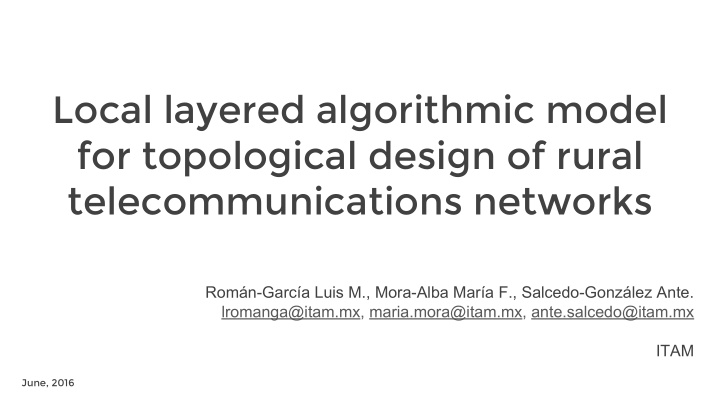



Local layered algorithmic model for topological design of rural telecommunications networks Román-García Luis M., Mora-Alba María F., Salcedo-González Ante. lromanga@itam.mx, maria.mora@itam.mx, ante.salcedo@itam.mx ITAM June, 2016
Contents Contribution ● Introduction ● Methodology & Implementation ● Results ● Future work & conclusions ● 2
Contribution
Contributions Methodology with a local layered algorithmic approach ● Baseline to estimate infrastructure requirements to ● deliver broadband coverage to unconnected communities of Mexico Consideration of road distances in the network design ● Applicable: We applied our model to two municipalities ● of the Mexican state of Chiapas General: Our model can be applied to other Mexican ● regions or at other countries 4
Introduction
Digitalization 2014: 40% of the global population used internet ● 2015: 4.5 billion mobile phone users ● Digitalization: “social transformation triggered by the ● massive adoption of digital technologies to generate, process, share and transact information” Proven impact on economy, society and governance ● Critical element is the development of ● telecommunications, including the design of connectivity networks 6
Networks at rural communities Urban networks are relatively inexpensive and easier to ● deploy and maintain; rural networks are the opposite Low development of the telecommunications networks ● in rural communities 23% of the total population in Mexico live in rural ● communities many of which lack of telecommunications services like mobile telephony or broadband access 7
Network design Very complex process ● Good network design is difficult to characterize, tradeoffs ● are necessary Topological design: ● Selection of the network nodes and their location ○ Definition of the mechanisms to connect them ○ Bandwidth capacity of the branches ○ We assumed the availability of the primary network, and ● focus on the secondary networks that need to be deployed 8
Methodology & implementation 9
Implementation Locality selection criteria Maximize impact ● Little coverage ○ Large populations ○ Worst case complexity ● 10
Implementation 11
Implementation 12
Implementation 13
Implementation 14
Implementation 15
Implementation 16
Implementation 17
Results 18
Results 19
Results 20
Results 21
Results Parameter Villaflores Tessellation Villa Corzo Tesselation Connected population 6,278 5,291 % Connected population 88.3% 60.1% Connected localities 18 21 Km of optic fiber 207.3 km 193.8 km 22
Future work and conclusions 23
Future Work Randomization in the centroid selection process to avoid bias. ● Incorporate boundary analysis. ● Implement Steiner tree theory to grow the tree. ● 24
Conclusion Our approach proves itself lightweight and efficient due to the ● locality constraint. The use of road-distances gives more realistic solutions than ● the Euclidean approach. As it can be appreciated with Villa Corzo, different thresholds ● should be considered depending on the sparsity and distribution of distinct populations. 25
Thanks 26
Recommend
More recommend